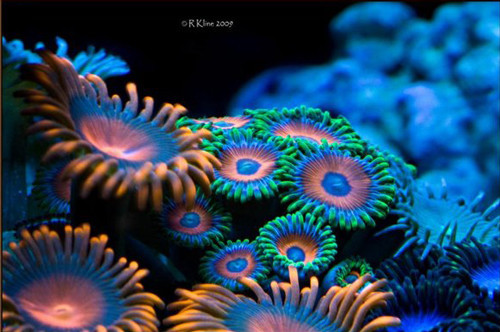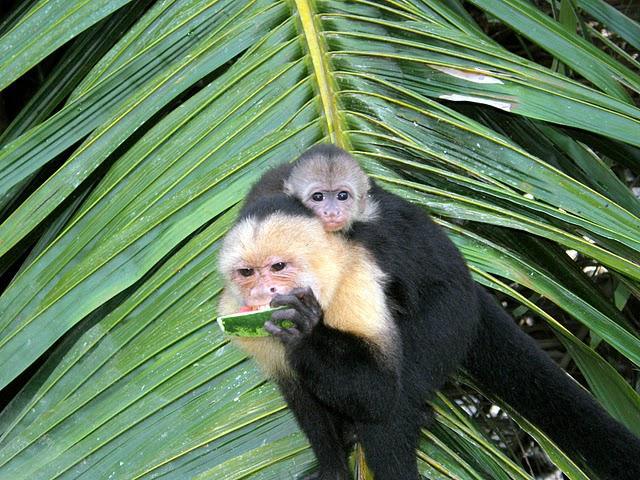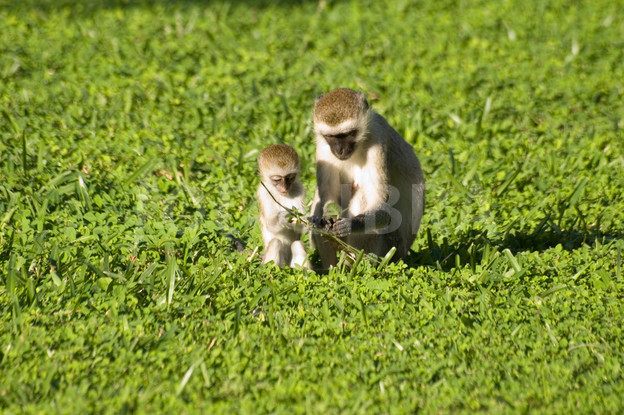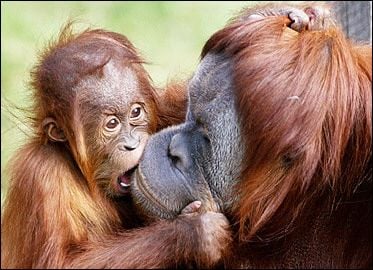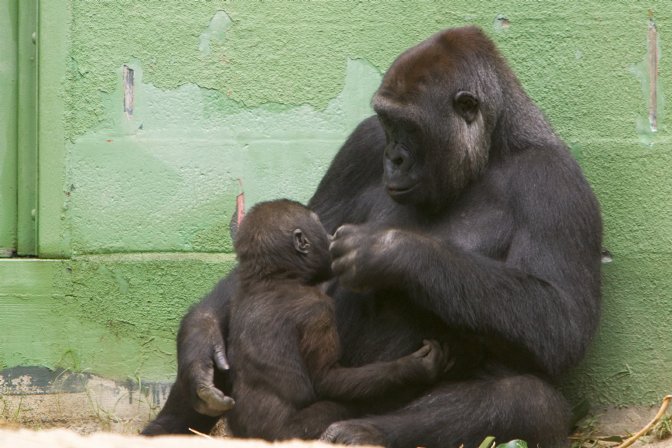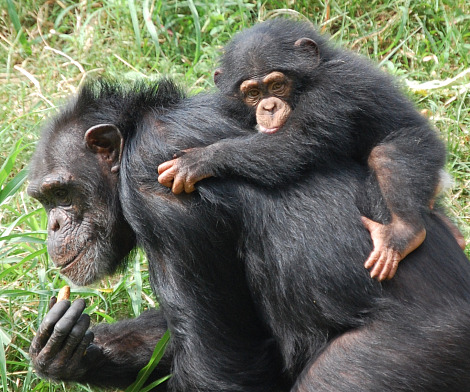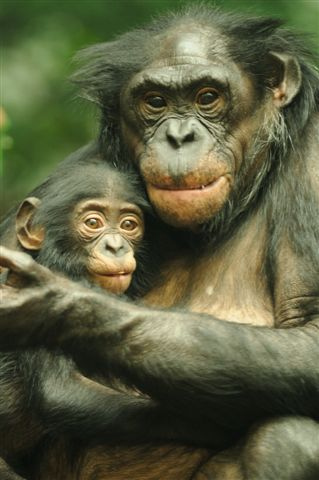Happy MOTHER’S Day, to all you primate momma’s out there!
In this article, I will attempt to provide the reader with a basic understanding as to the unique and vitally important roles primate mothers play in the development of their offspring as well as why we all ought to take some time today to thank the incredible female primate responsible for their own existence. I will divide this entry up into two parts; first, i’ll provide a general overview of primate mothers in comparison to other mammalian mothers and secondly, i’ll offer a more specific approach to a few species of primate mothers to provide examples.
Primate Moms, In Comparison To Other Mammalian Mothers:
Every primate that has ever lived owes its existence to its mother; a mother whose body underwent a complicated, physically stressful transformation – generally lasting several months. At the end of this physically expensive biological phenomenon, a primate mother generally gives birth to a single offspring (although some monkeys and prosimians frequently have twins). For primates, the entire pregnancy is often difficult; including the birthing process itself. Primates have large brains in comparison to their body size, which require a larger cranium to encase the brain. These large brains are quite useful in problem solving and forming beneficial social bonds with troop members; however, the large cranium is one of the features of primates which complicates the process of labour. Primate mothers struggle throughout the duration of their pregnancy in ways that are unseen in a vast majority of other animals, including in most other mammals.
However, the struggle does not end after the offspring have been delivered. The mother continues to devote an enormous amount of time, energy and resources to the development of her offspring for lengthy periods of time; considerably longer periods than is observed in a majority of other mammals. In many cases, a primate mom must raise the offspring almost exclusively on her own; though she may seek help from her daughters, provided she has some. During this period, the mother is responsible for her young, rambunctious and curious offspring – as well as for herself. She will now need to acquire food for two and maintain strong social bonds within her troop if she is to properly imprint upon her offspring the behavioral adaptations and survival tactics required for the continuity of her genetic line. This period of time is extremely dangerous for both mother and child and, tragically, primate mothers lacking sufficient environmental fitness are often unable to pass on their genetic variation to future generations.Perhaps unsurprisingly, Its not uncommon for primate babies to mimic their mothers every move; this feature has been ‘built in’ via natural selection as a mechanism of encouraging the baby to pick up its mothers advantageous characteristics.
Why then, if indeed we primates are evolved creatures, would we struggle in ways disproportionate to a vast majority of other mammals, only to create significantly fewer offspring? On its face, this seems a very difficult question to answer from an evolutionary standpoint; however, some quite interesting research has shed light onto why this struggle is necessary. Simple animals such as corals reproduce in a way that makes perfect sense from an evolutionary standpoint. After all, if the primary ‘goal’ of evolution is to get ones genes propagated in future generations; what could be a more effective means of doing so than creating genetically identical clones of oneself, and then living in ever expanding colonies of such clones? However, this survival tactic has an enormous liability built in – a dangerous lack of genetic variability. Genetic variability is extremely important, especially in cases involving environmental change. If, for example, water conditions change (pH drops, salinity fluctuates, pollution, etc) the genetically identical animals are likely going to have the same sort of reaction to such a change. This is where genetic variability and individual ‘fitness’ can play a substantial role.
Many animals reproduce sexually in circumstances which involve distinct male and female individuals. In these scenarios, the offspring acquire half of the genetic material from their mother and half from their father. This variability among populations of organisms allows for a variety of reactions to environmental changes; those with advantageous characteristics which allow them to survive such changes will go on to continue their genetic line, while those unable to adapt to the changes often parish without leaving offspring. So this helps explain why genetic variability in primates and other animals is important, but why is the process more difficult in primates than in other mammals?
For example, rodents (such as mice, rats and rabbits) and ungulates (such as deer and gazelle) often give birth to a greater number of offspring after a shorter, less complicated pregnancy. The labour process is also considerably less problematic in these mammals. The offspring of rodents and ungulates individually require much less of their mothers time and attention, and reach sexual maturity at younger ages. However, this tactic also has some built in problems as well. The mother has so many offspring simultaneously that it becomes extremely difficult for her to keep tabs on all of them at once. Consequently, her offspring are individually more prone to predation than are the individual offspring of higher mammals which have less offspring. Additionally, their smaller cranial capacity in comparison to body size, which makes their delivery easier, also deprives them of the kind of cognition we observe in primates and other higher mammals.
Primate moms offer among the best examples of devotion within the entire animal kingdom while demonstrating an almost poetic resilience to environmental factors in order to provide care to their beloved offspring. Now that I have covered the reasons why it may be evolutionarily beneficial for primate moms to sacrifice so much for each individual baby, i’ll cover some of the different examples of primate moms and the ways they contribute to the success of their individual offspring. Specifically, I will give an overview of the duties and social roles of marmoset monkey mothers, capuchin monkey mothers, vervet monkey mothers, chimpanzee mothers, bonobo mothers, orangutan mothers, gorilla mothers and human mothers.
Primate Mom Examples:
First, i’ll review the characteristics of our more distantly related primate cousins – the monkeys.
Marmoset Mom’s-
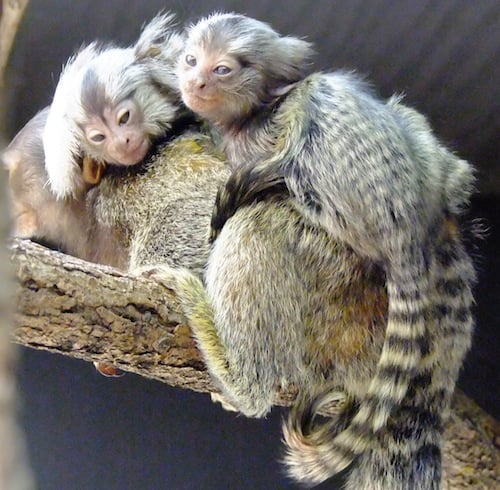
Callitrichid (marmoset and tamarin) monkeys generally live in groups of 5-20 individuals. Marmosets are actually a quite interesting primate to study because they, unlike most primates, are cooperative breeders like humans. This means that, in marmoset society, the moms receive help rearing their young; usually from the fathers as well as the mom’s sisters and daughters. Marmosets are also unusual among primates in that they give birth to twins more frequently than is seen in other primate species. Although polyandry (female mates w/ multiple males) and polygamy (male mates w/ multiple females) have both been observed within marmoset troops, it is generally accepted that marmoset monogamy is the norm; a characteristic of these little monkeys which many humans find quite endearing. Often times in callitrichid culture, the troops have a single ‘alpha’, breeding female who mates with the ‘alpha’ male; generally, the other monkeys will not have access to reproduction.
In marmoset troops with two sexually active females, the subordinate female rarely mates with male marmosets in her own troop and generally gives birth to ‘unfit’ offspring which die early on. However, if she decides to leave her troop or earns the hierarchal position of alpha, breeding female; she may have a chance to successfully rear offspring in the future. Marmoset babies will not leave their mothers backs voluntarily until after a period of about two weeks, and they continue to rely on their mothers to nurse until approximately 3 months of age. At approximately 5 months of age, they enter their ‘juvenile’ stage and require more supervision and guidance from related troop members other than their parents. Marmosets remain sub adults until they are approximately a year and a half old, at which point they are finally sexually mature and have reached full adult size; although they will not be allowed to breed until they have attained a dominate status, which can take many years. Marmoset subadults of both sexes are known to disperse from the troops they were born in, though females are slightly more likely to stay within their natal troops than are males.
Because the marmoset babies require a lot of energy from multiple, related group members; the breeding pair often attempts to subvert any attempts of their troop mates to reproduce. In accordance with Hamilton’s Rule (see below), the individuals not capable of reproducing engage in altruistic care of another’s offspring because the offspring shares some of their own genetic content. For example, ones overall ‘reproductive success’ is measured equally among individuals which produce offspring of their own and those who abstain from reproducing in order to increase the survival odds of 2 brothers or 8 cousins; which is, genetically speaking, roughly equivalent to them having reproduced themselves.
**Hamiltons Rule (a.k.a. Kin Selection) is represented by the equation rB>C, where r=genetic ‘relatedness’, B= reproductive ‘benefit’ gained by recipient of altruistic act and C= the reproductive ‘cost’ to individual performing altruistic act
Unlike their closely related marmoset cousins, capuchin monkeys tend only to give birth to a single offspring. Capuchins live in groups of between 10-40 individuals, usually headed by a single alpha male with breeding access to multiple females; except in white throated capuchin (Cebus capucinus) troops, which are dominated by both an alpha male and an alpha female. Another characteristic which makes them behaviorally distinct from marmosets is that the capuchin fathers rarely have a substantial role in the rearing of their offspring; leaving the females to do most of the work on their own.
However, similarly to marmosets, capuchins live in highly social, territorial troops in which social grooming, various meaningful vocalizations and social hierarchies are commonplace. Capuchin babies rely on a strong grip to hold on to their mothers chest until they have reached a larger size at a few months of age; at which point they move to clinging on her back when the mother moves around and they engage in more social behavior with monkeys other than their mothers. Capuchins take a longer time to reach sexual maturity, with females requiring around 4 years and males up to 8 years to achieve full sexual maturity. In capuchin society, females generally spend their entire lives in their natal groups with their female kin, while mature males venture off from their natal troops in search of a new troop over which they will attempt to become the alpha male with access to breeding. Typically, males will migrate to several different troops within their lifetime; learning many valuable leadership techniques along the way.
Vervet Mom’s-
Similar to capuchins, vervet monkey females remain in their natal groups with their female relatives for their whole lives. However, unlike capuchins, vervet’s have separate dominance hierarchies for each sex. Males determine their social status by their ability to display aggressive behaviors and maintain beneficial alliances; while female social status in vervet’s is determined by their maternal lineage. Females are, so to speak, ‘born into’ different ranks in the social hierarchy depending on who their mother is. Similarly to marmosets, vervet mothers receive help in the baby rearing process from related females; generally those which have not yet begun menstruation. Young female vervet’s will typically only ‘allomother’ babies which are their siblings, or those belonging to a high ranking female (likely in an attempt to increase their own social status by affiliation). The process of allomothering is extremely helpful not only to the mother, but also to the female allomother who becomes familiarized with the complicated process of being a monkey mother.
Vervet mothers nurse their young for approximately 4 months, during which time the babies ride on the mothers chest initially, and move to her back as they get larger. Baby vervet monkeys rely heavily on their mothers and other female troop members for the first 8-12 months of their lives. Vervet’s reach sexual maturity between 2-3 years depending on the locality of the population being studied.
Now, i’ll review the mothers role in Ape society..
Orangutan Mom’s-
Orangutan troops are similar to that of many other primates in that they are composed primarily of females and their offspring. Adult male orangutans are largely solitary animals which are highly territorial and generally look over and a few groups of unrelated females within their territory. Amazingly, orangutans require extremely long periods of time to become sexually mature; with females requiring 8-10 years and males some 10-15 years to reach full sexual maturity. Baby orangutans nurse from their mothers and remain clinging to her fur for several months, and are not fully weaned until around 4 years of age. Just like in humans, orangutan gestation lasts about 9 months and after this period of time the female usually gives birth to a single young.
Males play almost no role what so ever in the socialization or rearing of the young; instead preferring to socialize and play with males of a similar age. After the first four months when the baby is almost inseparably clinging to its mothers chest, the female relatives begin to play a much larger role in the rearing and socialization of the baby orangutan. By the time the orangutan toddler reaches the age of two, it has developed enough muscle mass to begin exploring the treetops with the guidance of an elder orangutan female who holds their hand. This adorable hand holding orangutan exploration is called ‘buddy travel’. Orangutans are considered juveniles from age 2 until age 5; at which point they begin to limit their contact with their mothers and start to spend more time with other troop members. Mother orangutans remain highly vigilant, dedicated mothers of each offspring for 6-8 years; abstaining from male sexual advances for that entire period.
Gorilla Mom’s-
Gorillas are excellent mothers and surprisingly gentle giants capable of providing the most delicate of care to their sweet, fuzzy babies. Gorillas also have a gestation period of about 8.5-9 months, and mothers are expected to rear the offspring with little if any help from the alpha male father of their baby. Gorillas live in troops consisting of a single alpha male (or silverback) and several female companions, along with their offspring. Female gorillas reach sexual maturity at around 10-12 years of age while males don’t generally become mature ‘silverbacks’ until they are 12-13 years old. Gorillas mate year round and female gorillas generally require four year intervals between the birth of each baby. When males reach sexual maturity, they will leave their natal groups in an attempt to establish dominance in another, unrelated troop.
Although the typical gorilla troop is comprised of an alpha male, ‘his’ females and their offspring; multiple male groups are also not uncommon. This is likely because there is strength in numbers. When young male gorillas leave their natal groups it is largely beneficial for them to congregate and work together to overcome the difficulties of a solitary life in search of a female troop (preferably under the watch of a silverback whose authority they think they could overturn). Although the mother is almost exclusively responsible for the rearing of her young, the silverback plays a vital role in regulating in-group violence and shielding the infants from aggressive behavior. For the first year of its life, a baby gorilla is very rarely seen more than 5 meters away from its mother. Between 18 and 24 months of age, the baby gorilla begins to venture further away from its mother for longer periods of time, though the baby usually returns every couple hours to suckle. By three years of age, young gorillas are only spending about half of the time with their mothers, preferring to spend time with other gorillas close to their own age. This allows the mother to have more freedom as well as providing the young gorilla with important socialization with its troop members. After the baby has become fully weaned (between 3-5 years old), the gorilla mother soon begins to ovulate and become sexually receptive again; which is generally followed by a pregnancy shortly thereafter. By six years of age, the young gorilla generally leaves its mothers sleeping nest to form its own.
Chimpanzee Mom’s-
Chimpanzees and Bonobos also have a gestation period of approximately 9 months, and usually give birth to a single, hairless baby weighing only 3-4 pounds. The mother is extremely protective of her feeble, fragile baby for the first few months, and does not let any other troop members near. Curious chimp babies, only a few months old, may try to venture away from the safety of their mothers to explore their surroundings; although this is usually to no avail, as the mother gently pulls her baby back toward her side, often tickling and playing to keep the baby interested in staying with her. By approximately 3 months of age, a baby chimpanzee begins to develop a white tuft on their rear which usually coincides with the further development of motor/muscular control. Between three and five months, a baby chimps first teeth emerge and they begin eating other types of food; though chimp mothers are often receptive to nursing their offspring until around age 5. At this point, a chimp would no longer be allowed access to moms milk or to take freely from the food she scavenged for. Generally, the chimp youngster is very upset by this, and tantrums are quite frequent.
By five months, the baby chimp is beginning to spend more time with other chimp youngsters in the multi-male, multi-female group in which it lives. Additionally, around this time the chimp youngster begins to ride on its mothers back instead of on her chest. Chimps at this age are extremely social, and quickly picking up on important social cues from their troop members. At around 6 months, baby chimps begin to mimic their mothers ability to make sleeping nests. For juvenile chimps of age 2-5, its all about playtime; however, at around 6 it becomes more important for them to start paying closer attention to subtle social cues and engage more frequently in social grooming. At around age 8-9, male chimps become much more aggressive and begin fighting for the dominate position within their troop.
Chimpanzee hierarchies are interesting, with troops consisting of an alpha male who has the foremost authority and various lesser ranked individuals underneath him. In chimpanzee society, the alpha male is not always the biggest or strongest; but is often the most manipulative, political chimp. Males show submission to the alpha male by extending their arms and grunting, while females demonstrate submission by presenting the alpha male with their hind quarters. The alpha male is responsible for regulating conflicts among lesser ranked troop members, ensuring the safety of his troop members and maintaining his position as the alpha male of his troop. Similar to orangutans, female chimps also have a ‘pecking order’ and have their dominance largely determined by the social status of their mothers. Additionally, female chimps often form complex alliances to dominate lesser ranked females. Males, on the other hand, determine their social status through manipulative, political and social means.
Bonobo Mom’s-
Despite being extremely similar to chimpanzees physically (bonobos being slightly smaller and walking more upright), the behaviors of bonobos are quite distinct from that of their chimp cousins. When confronted with a perplexing situation, chimps often resort to violence whereas bonobos often resort to group sex. Bonobos are very dedicated mothers of offspring whose early developmental processes are very similar to that of chimpanzees; however, the culture in which they are raised is quite different. Bonobo troops are headed by females rather than males as in chimpanzees. This makes for a quite substantial difference in the way the troops operate. In bonobo troops, the status of both males and females is derived from the social status of the individuals mother; rather than by their ability to be aggressive, dominant or manipulative. Bonobo babies stay with and nurse from their moms until they are weaned at around 4.5-5 years old. Social hierarchies do still exist within bonobo troops, however they are considerably less deterministic and important in bonobo troops.
Sexual behaviors are observed in every aspect of bonobo culture and are not constrained to particular ages or even genders. Sexual relations between all combinations of sex, age and relation are quite frequent in bonobo communities. The extremely close, and often sexual, relationships between bonobo females allow them to hold a dominate position over the males. Male bonobos are individually stronger, but would stand little chance against an alliance of female bonobos. In bonobos as in chimps, it is more common for the females to leave their natal troops once reaching an age of around 8-10 years old; which is an extremely dangerous time in a female chimp/bonobo’s life, as the jungle is a very dangerous place to be alone. However, this is an important characteristic which enables these apes to maintain genetic diversity and avoid inbreeding;
Human Mom’s-
Without doubt, the most invested mothers within the animal kingdom are the mothers responsible for raising those individuals capable of reading this – human mothers. Humans have the longest life expectancy of any extant primate, develop more slowly than any other primate and have a longer period of maternal reliance than any other animal. For these reasons, human moms are the rockstars of the animal mom world. It would be difficult to answer what the universal role of a human mother is – largely because our culture has evolved in so many different ways as to render the likelihood of agreement on one distinct answer to this question rather unlikely. I suspect that if you asked 100 different human moms what it meant to be a mom, you’d get 100 different answers.
The only working definition I could provide for the role of human mother, which would be biased, would be something like this:
A human mothers role is to be caring, dedicated, unconditionally loving, involved in her children’s lives and supportive of her children’s pursuits. A good human mother encourages her children to think for themselves, rather than filling their heads with opinions about the world which she holds. A good human mother accepts her child, regardless of the child’s predicament and is always there to provide maternal support and insightful advice about how to deal with the various complications of the everyday human experience. A good human mother stops at nothing to ensure that her children have the kinds of opportunities in their lives that she wished she could have had access to as a child. A good human mother realizes that the success of her children is her success also, and a good human mother raises individuals likely to be good human mothers and fathers themselves.
Fortunately for me, I didn’t only have a good human mother – I have the absolute best mother I could ever have imagined. A truly amazing, inspiring woman who completely embodies every bit of my above definition of the role of a human mother.
Happy Mothers Day to my mom, Amy Taitt, as well as all the other primate moms out there today!
I couldn’t be more proud of the remarkable woman with whom I share 50% of my genetic makeup, nor could I be more proud to belong to what I believe to me the most awe inspiring animal order in existence – Primates.
🙂
Photo Credits:
Coral Photo – http://www.noupe.com/photography/coral-photography-for-your-inspiration.html
Marmoset Mom- http://blog.niagaraparks.com/news/help-niagara-parks-and-little-rays-name-the-baby-marmoset-twins/
Capuchin Mom- http://costaricawildlife.wordpress.com/march-2011-trip/
Vervet Mom- http://www.fotolibra.com/gallery/197142/vervet-monkey-mother-teaching-baby/
Orangutan Mom- http://daughterearth.com/blog/2009/05/m-o-m-missing-orangutan-mothers/
Gorilla Mom- http://www.ics.uci.edu/~eppstein/pix/sdz3/NursingGorilla.html
Chimp Mom- http://www.zooborns.com/zooborns/2009/09/baby-chimp-zoe-oklahoma-city-zoo.html
Bonobo Mom- http://www.flickr.com/photos/cincinnatizoo/4537983213/
